How the Model Calculates Life-Cycle Costs
Throughout the model, all white fields are for you to modify. The shaded sections contain calculations... any modification to them would invalidate the results.
The loads input page collects all the items that you may have on board. You enter amp draws and duration, the model then calculates your daily amp-hour needs. The runtime load influences the amount of current that can be used to refill your batteries. This benefits flooded battery users in particular, since their batteries tend to absorb less energy than AGM or Gel batteries. The assumption is that run-time loads are satisfied before charging can take place.
Naturally, the model compensates for reduced charge requirements if house loads on batteries are "avoided" during recharge. More on this in the ReadMe file that accompanies the cost model. Also, keep in mind that these results are for BULK charging only. All lead-acid battery types revert to much lower charging rates during absorption and float. I also built a model to deal with this, although it is much more involved than the simple bulk charging model shown here. Send me an e-mail if interested (see link below)
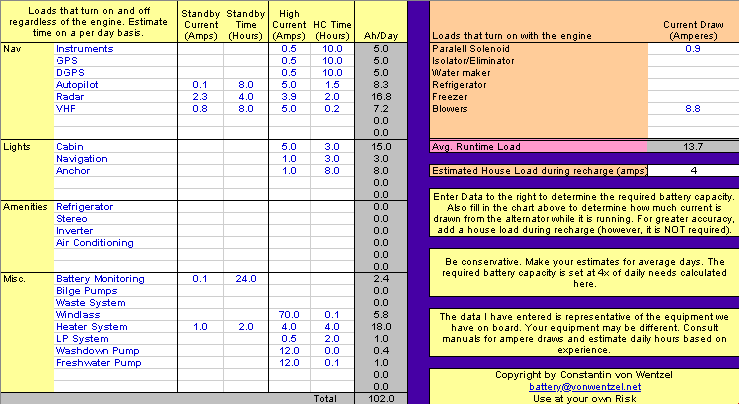
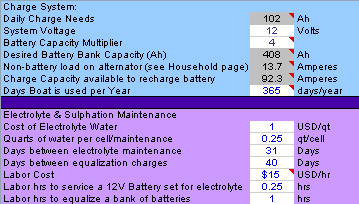
Amp-hour Requirements
The first section of the second page calculates the number of amp-hours needed per day. Then it is up to you to specify the voltage of your system and what kind of capacity multiplier factor you want to use.
The capacity multiplier is a measure of how much larger the battery bank is supposed to be than your daily needs. The most commonly advocated factor is 4x though some practioners go as low as 3x. The question is how much battery reserve you want to or can carry.
Then the model queries how many days a year you intend to use the boat, as well as maintenance costs associated with your batteries. Sulphation and electrolyte maintenance only applies to flooded cells since VRLAs don't require such maintenance.
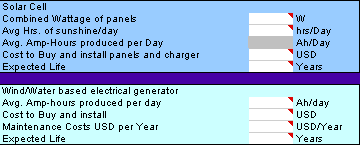
The Renewable Energy Section:
The renewable energy section allows you to enter the parameters of your renewable energy sources. We don't have any so our sections are blank. However, you can use this section to see if your net USD/day cost goes down should you install a renewable energy system. Particularly liveaboards can benefit from a relatively low life cycle cost of a renewable energy system.
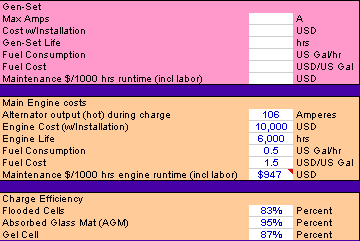
Producing Power with Combustion Engines:
The next section busies itself with combustive ways to generate electricity. Here each source of charge is characterized by life, maintenance costs, etc. As applicable, you should change the parameters to reflect the situation on your boat. At the very bottom you can set the various charge efficiencies by battery type.

The battery properties section allows you to chose batteries by number (the data is on another page). The left-most column is the baseline, the column to the right holds the data for the 3D comparison. In this example, the Lifeline AGM is the baseline, which is compared to a Surrette 12CS11 on the 3D page.
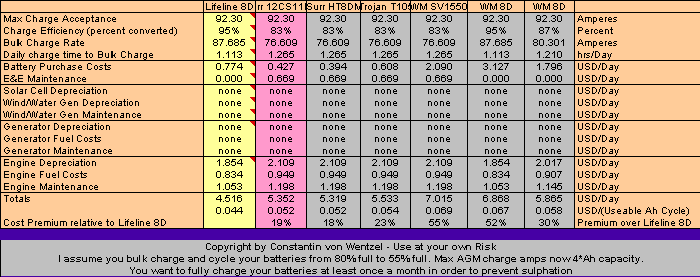
The last section calculates the net cost per day by category and battery type. It also calculates the relative cost premium of each battery technology relative to the Lifeline AGM baseline battery. If a cost does not apply (for example, you don't use a wind generator) the model returns "none".
Downloading the Cost Model:
Properly sizing a battery system to match a load is pretty simple, if tedious. The spreadsheet allows you to input the values from your equipment manuals and see just how much battery capacity you will need. Furthermore, you can compare system costs from battery to battery depending on how much time you spend on board, battery parameters, and charging options. This is the kind of information that magazines should publish because as we consultants like to say: "it all depends".
You can now download two versions of the Bulk Charging Model along with a read me file describing its use in depth. One version is meant for PC users and comes in the .ZIP format. Macintosh users can download a smaller .sit archive.
Naturally, I'd love to hear about your impressions and suggestions for improvements. Many thanks for your interest and I hope this tiny model will help you make an informed decision.
Sizing Wiring the ABYC Way:
Another fun project was creating a automatic lookup table for ABYC electrical wire size requirements. This Excel file will basically translate voltage drop requirements and ampere draws into American Wire Gauge (AWG) wire sizes. I make no guarantees about accuracy, but it seems to work.
This Excel spreadsheet was very useful for rewiring our boat as it allowed me to order wiring in bulk and in advance.


